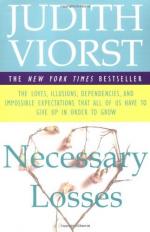|
This section contains 468 words (approx. 2 pages at 400 words per page) |

|
Necessary Losses Summary & Study Guide Description
Necessary Losses Summary & Study Guide includes comprehensive information and analysis to help you understand the book. This study guide contains the following sections:
This detailed literature summary also contains Topics for Discussion and a Free Quiz on Necessary Losses by Judith Viorst.
Judith Viorst's "Necessary Losses" is a compendium of philosophies, studies, opinions, poetry, literary excerpts and anecdotes that define her outlook on life, childhood, maturity, grief, sexuality, old age and death. Always with a sense of humor, she packs this book with loads of food for thought about every stage of life, and how each one affects us as adults.
The losses necessary for growth, health and maturity begin with the loss of our oneness with our birth mother, who feeds, protects and loves us unconditionally. Other losses include the movement through the stages of life, when we lose our definitions of who we thought we were, and move on to create new ones. As she moves through the psychological losses of childhood, Viorst increasingly addresses the tangible losses of loved ones, marriage, the death of children and the losses that devastate us and change the course of our lives. Although our childhood losses can be insurmountable, we usually find ways to compensate and reframe our lives so that we can continue.
Viorst discusses the different ways in which people deal with grief and its devastating effect on our lives. She emphasizes that completion of the mourning process is important to mental and physical health. Becoming stuck in obsessive grief leads to illness. Grief is a process that we must move through, and we do live through it even when it seems impossible.
Aging, another "loss" is an issue that many do not want to face. We often see aging people as disposable and inconvenient, since they are not able to participate any longer. Further, we sometimes see ourselves the same way as our bodies begin to fail us and we are often left alone. Viorst gives numerous examples of how to age with vitality and life, and how the aging process can offer us opportunities for growth and change, even in the latest years of our lives.
Finally, Viorst relieves us of the notion that we must die gracefully and follow the rules of going through the proper stages of death. She insists that everyone has a different way to die, based on their personalities, their attachments, interests and innate traits. She uses the examples of her sister and friends, each of whom chose a different method of dealing with their impending death. Viorst feels it is appropriate to commit suicide or to resist death until the end if that is what we choose, since there is no correct way to die.
This delightful book opens up questions about marriage, divorce and every stage of living, as well as dying. Although Viorst bases her conclusions on the research and thoughts of others, she has clearly thought through what it takes to live a life well, and has shared some valuable insights with her readers.
Read more from the Study Guide
|
This section contains 468 words (approx. 2 pages at 400 words per page) |

|



